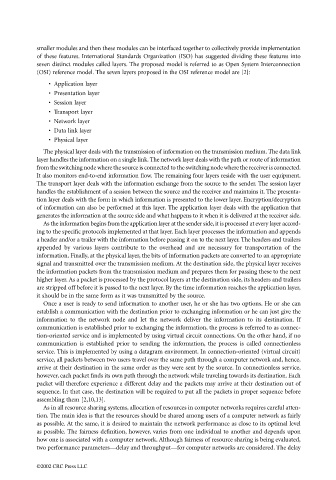Page 1074 - The Mechatronics Handbook
P. 1074
smaller modules and then these modules can be interfaced together to collectively provide implementation
of these features. International Standards Organization (ISO) has suggested dividing these features into
seven distinct modules called layers. The proposed model is referred to as Open System Interconnection
(OSI) reference model. The seven layers proposed in the OSI reference model are [2]:
• Application layer
• Presentation layer
• Session layer
• Transport layer
• Network layer
• Data link layer
• Physical layer
The physical layer deals with the transmission of information on the transmission medium. The data link
layer handles the information on a single link. The network layer deals with the path or route of information
from the switching node where the source is connected to the switching node where the receiver is connected.
It also monitors end-to-end information flow. The remaining four layers reside with the user equipment.
The transport layer deals with the information exchange from the source to the sender. The session layer
handles the establishment of a session between the source and the receiver and maintains it. The presenta-
tion layer deals with the form in which information is presented to the lower layer. Encryption/decryption
of information can also be performed at this layer. The application layer deals with the application that
generates the information at the source side and what happens to it when it is delivered at the receiver side.
As the information begins from the application layer at the sender side, it is processed at every layer accord-
ing to the specific protocols implemented at that layer. Each layer processes the information and appends
a header and/or a trailer with the information before passing it on to the next layer. The headers and trailers
appended by various layers contribute to the overhead and are necessary for transportation of the
information. Finally, at the physical layer, the bits of information packets are converted to an appropriate
signal and transmitted over the transmission medium. At the destination side, the physical layer receives
the information packets from the transmission medium and prepares them for passing these to the next
higher layer. As a packet is processed by the protocol layers at the destination side, its headers and trailers
are stripped off before it is passed to the next layer. By the time information reaches the application layer,
it should be in the same form as it was transmitted by the source.
Once a user is ready to send information to another user, he or she has two options. He or she can
establish a communication with the destination prior to exchanging information or he can just give the
information to the network node and let the network deliver the information to its destination. If
communication is established prior to exchanging the information, the process is referred to as connec-
tion-oriented service and is implemented by using virtual circuit connections. On the other hand, if no
communication is established prior to sending the information, the process is called connectionless
service. This is implemented by using a datagram environment. In connection-oriented (virtual circuit)
service, all packets between two users travel over the same path through a computer network and, hence,
arrive at their destination in the same order as they were sent by the source. In connectionless service,
however, each packet finds its own path through the network while traveling towards its destination. Each
packet will therefore experience a different delay and the packets may arrive at their destination out of
sequence. In that case, the destination will be required to put all the packets in proper sequence before
assembling them [2,10,13].
As in all resource sharing systems, allocation of resources in computer networks requires careful atten-
tion. The main idea is that the resources should be shared among users of a computer network as fairly
as possible. At the same, it is desired to maintain the network performance as close to its optimal level
as possible. The fairness definition, however, varies from one individual to another and depends upon
how one is associated with a computer network. Although fairness of resource sharing is being evaluated,
two performance parameters—delay and throughput—for computer networks are considered. The delay
©2002 CRC Press LLC

